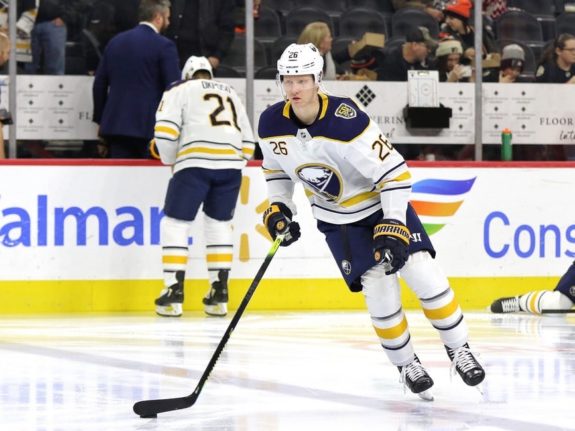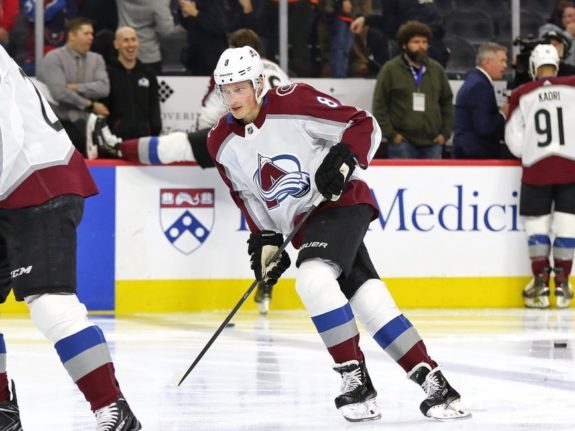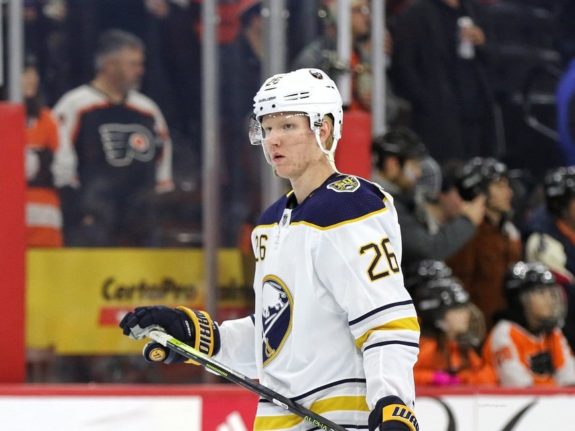In the last few years, the NHL has seen a massive influx of young, talented defensemen, but few garnered as much hype as the Buffalo Sabres’ 2018 first-overall pick, Rasmus Dahlin. Frequently compared to fellow countrymen Erik Karlsson and Victor Hedman, the bar was set exceptionally high before Dahlin played his first NHL game.
Related: Solutions to Sabres’ Special Teams Struggles
Despite coming off an impressive rookie season, the Sabres’ seemingly never-ending rebuild and the arrival of young defensive stars like Quinn Hughes (Vancouver Canucks) and Cale Makar (Colorado Avalanche) have pushed Dahlin to the back of some people’s minds. Though he might have flown under the radar in 2019-20, make no mistake, the young Swede’s breakout is imminent.
Dahlin Among the Sabres’ Best
Despite an unsteady start at 5-on-5, Dahlin made a claim for Buffalo’s best defenseman this season. Per Evolving-Hockey, his 1.33 even-strength points per 60 were the highest on the team among defensemen, as were his individual expected-goals per 60 (.27) and goals-against per 60 (1.95). Furthermore, he was second-last in even-strength ice time among Sabres defensemen, averaging 15:06 per game.
Despite his limited opportunities, he led the group with 20 even-strength points and points overall with 40. At only 19 years old, he was by far the best Sabres blueliner in many important analytical categories, and the gap will widen as he matures.

Unfortunately, Dahlin suffered a concussion towards the end of November and missed eight games. Jordan Deshane broke down his resurgence after returning to the lineup, but it’s worth looking at how his season compared to the top defensemen in the league, both before and after his concussion.
Prior to his injury, Dahlin was clicking at 1.37 points per 60 and 3.26 individual shots per 60; strong numbers but he didn’t quite look like the same defenseman as in his rookie year. He was unsteady in his own zone, committing 2.37 turnovers per 60, wasn’t as productive at even strength nor as confident with the puck in transition. After he returned, though, he jumped to 2.11 points per 60, 5.01 individual shots per 60 and his turnovers dropped to 2.2 per 60, a promising improvement.
That 2.11 points per 60 at all strengths was good for 8th in the NHL among defensemen with at least 500 minutes played; and if you limit that time frame from Dec. 12 to March 12, when he returned healthy until the season stoppage, he would rank 6th. Furthermore, he finished 5th overall in primary assists per 60 behind Hedman, Torey Krug, Makar and John Carlson, and was 2nd in secondary assists per 60 behind Tony DeAngelo (Evolving-Hockey).
Dahlin vs. Makar and Hughes
Both Hughes and Makar compare favorably on paper to Dahlin this season, but that isn’t to slight the young Swede. While Makar and Hughes were rookies this season and historic ones at that, Dahlin made the jump to the NHL last season. He’s younger than Hughes by 6 months and younger than Makar by a year and a half. Despite his 5-on-5 inconsistencies this season, Dahlin’s 1.33 even-strength points per 60 were better than Hughes’ 1.26, although that is largely thanks to his advantage in secondary assists.
Related: Sabres Need to Trade Their First-Round Pick
While Dahlin hasn’t put together a full season quite like Hughes or Makar, the quality of their supporting casts is also important. Makar and Hughes almost immediately became the Avalanche’s and Canucks’ best defensemen, per Evolving-Hockey’s WAR model, but they also had more support than Dahlin – both teams will be playing playoff hockey should the season resume.

By no means were they passengers on good teams, Makar and Hughes drove their teams’ success, but as Buffalo continues to add depth to their squad, I wouldn’t be surprised to see Dahlin make a similar jump next season when he’s a year more mature.
Why Dahlin Will Become a Star
Why else will Dahlin make a significant leap in his third season? An additional year under bench boss Ralph Kruger and the stability of having a coach and a system through a full offseason will be one factor. The Sabres have been kicking tires on a rebuild for years now, but the players seem to enjoy playing for Kruger and consistent coaching should help the young defenseman during a crucial time in his development. Additionally, reinforcements from the pipeline, like Dylan Cozens, Casey Mittlestadt, Will Borgen and others and bounce-back seasons from forwards like Jeff Skinner and Marcus Johansson could provide the offensive boost that the team needs.
Related: Sabres’ 2019-20 Analytics Autopsy – Forwards
The Sabres, and their new general manager Kevyn Adams, can help Dahlin significantly with one simple move: trading Rasmus Ristolainen. The big Finnish defenseman has regressed in recent seasons and has become an analytics disaster. Now that Dahlin has proven to be the superior power-play quarterback, Buffalo should trade Ristolainen while he still has value. A team will want the big right-shot defenseman, and the heavy minutes he plays would be much better served by Dahlin.

The main reason Dahlin will break out next year, though, is how his pace compares to others who have come before him. In his rookie season, the Sabres scored 221 goals, and he was involved in just under 20% of them with 44 points. Last season, his 40 points were just over 20% of Buffalo’s 193 goals. That number should rise as he matures and gets stronger, as should his current 4.9% shooting percentage (Hockey-Reference).
Comparatively, Erik Karlsson contributed about 12% of Ottawa’s goals in his rookie season and 23% in his sophomore campaign. His third year? At 21 years old, his 19 goals and 59 assists contributed to 32% of the Senators’ goals. Additionally, Dahlin’s 45 even-strength points in 141 games edge out Hedman’s 42 in 153 games over his first two seasons. Dahlin may not become as dominant as Karlsson and Hedman, but the potential is there and he’s outpaced them over his first two seasons.
The Sabres have the makings of an elite young core with Jack Eichel up front and Dahlin on the blue line. While we’ve seen Eichel explode into one of the league’s best forwards, defensemen generally take more time to develop, and I don’t think we’ll have to wait much longer for Dahlin’s breakout.
With nearly two full NHL seasons under his belt, he’s cemented himself as one of the Sabres’ best defensemen, and he’s on par or ahead of the young, talented blueliners who have come before him. With an increased role and ice time, continued development and improvement in his own end at even strength, and another year with Kruger, I expect Dahlin to have a big season in 2020-21.